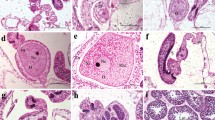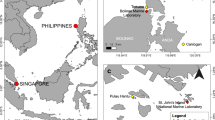Abstract
Coral-reef community structure has generally changed following declines in coverage by reef-building organisms. Ascidians as fast-growing, filter-feeding organisms, are of concern due to their invasiveness potential, but few studies have examined their life-history traits in tropical environments. The present study examined the distribution, settlement patterns, and reproductive cycle of the solitary, hermaphroditic ascidian Halocynthia spinosa in Eilat, Red Sea (29°30′N, 34°55′E), from August 2013 to August 2015. This species has a native distribution in the western Indian Ocean, with a continuous presence along the southern and eastern coasts of Africa. In Eilat, the field survey found that H. spinosa was prevalent in shallow depths, on cryptic, shaded substrates. Histological analysis of spermatogenesis and oogenesis, and a determination of the gonad index in monthly samples revealed a seasonal reproductive cycle that was significantly correlated with seawater temperature, associated with photoperiod and food availability. All measures of reproduction showed the highest activity in the summer (June–August), and a short resting period in the winter months (December–March). H. spinosa individuals were rarely observed on artificial structures. Thus, the introduction of H. spinosa into new regions as part of a fouling community is relatively unlikely. These findings contribute to understanding ecological interactions of non-reef-building organisms such as ascidians, and add to the knowledge of ascidian reproductive patterns.






Similar content being viewed by others
References
Abelson A, Loya Y (1999) Interspecific aggression among stony corals in Eilat, Red Sea: a hierarchy of aggression ability and related parameters. Bull Mar Sci 65:851–860
Bak R, Sybesma J, van Duyl F (1981) The ecology of the tropical compound ascidian Trididemnum solidum II abundance, growth and survival. Mar Ecol Prog Ser 6:43–52
Bak RPM, Lambrechts DYM, Joenje M, Nieuwland G, Van Veghel MLJ (1996) Long-term changes on coral reefs in booming populations of a competitive colonial ascidian. Mar Ecol Prog Ser 133:303–306
Bates WR (2005) Environmental factors affecting reproduction and development in ascidians and other protochordates. Can J Zool 83:51–61
Becerro MA, Turon X (1992) Reproductive cycles of the ascidians Microcosmus sabatieri and Halocynthia papillosa in the northwestern Mediterranean. Mar Ecol 13:363–373
Bingham BL (1997) Light cycles and gametogenesis in three temperate ascidian species. Invertebr Biol 116:61–70
Blum JC, Chang AL, Liljesthröm M, Schenk ME, Steinberg MK, Ruiz GM (2007) The non-native solitary ascidian Ciona intestinalis (L.) depresses species richness. J Exp Mar Biol Ecol 342:5–14
Bower AS, Hunt HD, Price JF (2000) Character and dynamics of the Red Sea and Persian Gulf outflows. J Geophys Res 105:6387–6414
Bullard SG, Carman MR (2009) Current trends in invasive ascidian research. In: Wilcox CP, Turpin RB (eds) Invasive species: detection, impact and control. Nova Science Publishers Inc, New York, pp 57–79
Bullard SG, Lambert G, Carman MR, Byrnes J, Whitlatch RB, Ruiz G, Miller RJ, Harris L, Valentine PC, Collie JS, Pederson J (2007) The colonial ascidian Didemnum sp. A: current distribution, basic biology and potential threat to marine communities of the northeast and west coasts of north America. J Exp Mar Biol Ecol 342:99–108
Carlson DF, Fredj E, Gildor H (2014) The annual cycle of vertical mixing and restratification in the Northern Gulf of Eilat/Aqaba (Red Sea) based on high temporal and vertical resolution observations. Deep-Sea Res Part I Oceanogr Res Pap 84:1–17
Dame RF, Bushek D, Prins TC (2001) Benthic suspension feeders as determinants of ecosystem structure and function in shallow coastal waters. In: Reise K (ed) Ecological comparisons of sedimentary shores. Springer, Berlin, pp 11–38
Durante KM, Sebens KP (1994) Reproductive ecology of the ascidians Molgula citrina (Alder & Hancock, 1848) and Aplidium glabrum (Verrill, 1871) from the Gulf of Maine, USA. Ophelia 39:1–21
Genin A, Lazar B, Brenner S (1995) Vertical mixing and coral death in the Red Sea following the eruption of Mount Pinatubo. Nature 377:507–510
Giese AC, Pearse JS (1974) Reproduction of marine invertebrates. Academic Press, New York
Gittenberger A, van Stelt RC (2011) Artificial structures in harbors and their associated ascidian fauna. Aquat Inv 6:413–420
Goodbody I (1961) Continuous breeding in three species of tropical ascidian. Proc Zool Soc Lond 136:403–409
Hoegh-Guldberg O, Mumby PJ, Hooten AJ, Steneck RS, Greenfield P, Gomez E, Harvell CD, Sale PF, Edwards AJ, Caldeira K, Knowlton N, Eakin CM, Iglesias-Prieto R, Muthiga N, Bradbury RH, Dubi A, Hatziolos ME (2007) Coral reefs under rapid climate change and ocean acidification. Science 318:1737–1742
Hurlbut CJ (1993) The adaptive value of larval behavior of a colonial ascidian. Mar Biol 115:253–262
Jones CG, Lawton JH, Shachak M (1994) Organisms as ecosystem engineers. Oikos 69:373–386
Koplovitz G, Shmuel Y, Shenkar N (2016) Floating docks in tropical environments—a reservoir for an opportunistic ascidian. Manag Biol Invasions 7:43–50
Lambert G (2002) Nonindigenous ascidians in tropical waters. Pac Sci 56:291–298
Lambert G (2005) Ecology and natural history of the protochordates. Can J Zool 83:34–50
Lengyel NL, Collie JS, Valentine PC (2009) The invasive colonial ascidian Didemnum vexillum on Georges Bank—ecological effects and genetic identification. Aquat Inv 4:143–152
Loya Y (2004) The coral reefs of Eilat—past, present and future: three decades of coral community structure studies. In: Rosenberg E, Loya Y (eds) Coral health and disease. Springer, Heidelberg, pp 1–34
McHenry MJ (2005) The morphology, behavior, and biomechanics of swimming in ascidian larvae. Can J Zool 83:62–74
Michaelsen W (1918a) Die ptychobranchen und diktyobranchen ascidien des westlichen Indischen Oceans. Jahrb Wiss Anst Hamburg 35:1–73
Michaelsen W (1918b) Ascidia ptychobranchia und diktyobranchia des Roten Meeres. Denkschr Akad WissWien 95:1–121
Millar RH (1962) Further descriptions of South African ascidians. Ann S Afr Mus 46:113–221
Millar RH (1964) South African ascidians collected by Th. Mortensen, with some additional material. Vidensk Medd Dansk Naturh Foren 127:159–180
Millar RH (1971) The biology of ascidians. Adv Mar Biol 9:1–100
Millar RH (1974) A note on the breeding season of three ascidians on coral reefs at Galeta in the Caribbean Sea. Mar Biol 28:127–129
Millar RH (1975) Ascidians from the Indo-West-Pacific region in the Zoological Museum, Copenhagen (Tunicata, Ascidiacea). Steenstrupia 20:205–336
Millar RH (1988) Ascidians collected during the International Indian Ocean Expedition. J Nat Hist 22:823–848
Monniot C (1973) Redescription de six ascidies du golfe d’Elat recoltées par H. Schuhmacher. Isr J Zool 22:51–62
Monniot C, Monniot F, Laboute P (1991) Coral reef ascidians of New Caledonia. ORSTOM, Paris
Monniot C, Monniot F, Griffiths CL, Schleyer M (2001) South African ascidians. Ann S Afr Mus 108:1–141
Monteiro SM, Chapman MG, Underwood AJ (2002) Patches of the ascidian Pyura stolonifera (Heller, 1878): structure of habitat and associated intertidal assemblages. J Exp Mar Biol Ecol 270:171–189
Nandkeolyar N, Raman M, Kiran GS (2013) Comparative analysis of sea surface temperature pattern in the eastern and western gulfs of Arabian Sea and the Red Sea in recent past using satellite data. Int J Oceanogr 2013:501602-1–501602-16. doi:10.1155/2013/501602
Osman RW, Whitlatch RB (2004) The control of the development of a marine benthic community by predation on recruits. J Exp Mar Biol Ecol 311:117–145
Pandolfi JM, Bradbury RH, Sala E, Hughes TP, Bjorndal KA, Cooke RG, McArdle D, McClenachan L, Newman MJ, Paredes G, Warner RR (2003) Global trajectories of the long-term decline of coral reef ecosystems. Science 301:955–958
Peck LS, Clark MS, Power D, Reis J, Batista FM, Harper EM (2015) Acidification effects on biofouling communities: winners and losers. Glob Chang BIol 21:1907–1913
Pérès JM (1960) Sur une collection d’ascidies de la côte israelienne de la Mer Rouge et de la péninsule du Sinai. Bull Sea Fish Res Haifa 30:39–47
Pineda MC, López-Legentil S, Turon X (2013) Year-round reproduction in a seasonal sea: biological cycle of the introduced ascidian Styela plicata in the western Mediterranean. Mar Biol 160:221–230
Raijman-Nagar L, Shenkar N (2016) From tropical to sub-tropical: prolonged reproductive activity of the invasive ascidian Microcosmus exasperatus in the eastern Mediterranean. Front Ecol Environ 4:102. doi:10.3389/fevo.2016.00102
Riisgård HU, Bondo Christensen P, Olesen NJ, Petersen JK, Møller MM, Andersen P (1995) Biological structure in a shallow cove (Kertinge Nor, Denmark) Control by benthic nutrient fluxes and suspension-feeding ascidians and jellyfish. Ophelia 41:329–344
Ritzmann NF, Da Rocha R, Roper JJ (2009) Sexual and asexual reproduction in Didemnum rodriguesi (Ascidiacea, Didemnidae). Iheringia Sér Zool 99:106–110
Rius M, Pineda MC, Turon X (2009) Population dynamics and life cycle of the introduced ascidian Microcosmus squamiger in the Mediterranean Sea. Biol Invasions 11:2181–2194
Rius M, Branch GM, Griffiths CL, Turon X (2010) Larval settlement behavior in six gregarious ascidians in relation to adult distribution. Mar Ecol Prog Ser 418:151–163
Rocha RM, Lotufo TM, Rodrigues SD (1999) The biology of Phallusia nigra (Savigny, 1816) (Tunicata: Ascidiacea) in southern Brazil: spatial distribution and reproductive cycle. Bull Mar Sci 64:77–88
Sahade R, Tatián M, Esnal G (2004) Reproductive ecology of the ascidian Cnemidocarpa verrucosa at Potter Cove, South Shetland Islands, Antarctica. Mar Ecol Prog Ser 272:131–140
Shenkar N (2012) Ascidian (Chordata, Ascidiacea) diversity in the Red Sea. Mar Biodiv 42:459–469
Shenkar N, Loya Y (2008) The solitary ascidian Herdmania momus: native (Red Sea) versus non-indigenous (Mediterranean) populations. Biol Invasions 10:1431–1439
Shenkar N, Swalla BJ (2011) Global diversity of Ascidiacea. PLoS One 6:e20657
Shenkar N, Bronstein O, Loya Y (2008a) Population dynamics of a coral reef ascidian in a deteriorating environment. Mar Ecol Prog Ser 367:163–171
Shenkar N, Zeldman Y, Loya Y (2008b) Ascidian recruitment patterns on an artificial reef in Eilat (Red Sea). Biofouling 24:119–128
Shenkar N, Gittenberger A, Lambert G, Rius M, da Rocha RM, Swalla BJ, Turon X (2014) Ascidiacea world database. http://www.marinespecies.org/ascidiacea. Accessed 12 Oct 2014
Sluiter CP (1905) Tuniciers récueillis en 1904 par M. Ch. Gravier dans la golfe de Tadjourah (Somalie Française). Mém Soc Zool Fr 18:5–21
Sommer B, Harrison PL, Scheffers SR (2010) Aggressive colonial ascidian impacting deep coral reefs at Bonaire, Netherlands Antilles. Coral Reefs 29:245
Svane I, Lundälv T (1981) Reproductive patterns and population dynamics of Ascidia mentula of Müller on the Swedish west coast. J Exp Mar Biol Ecol 50:163–182
Svane I, Young CM (1989) The ecology and behavior of ascidian larvae. Oceanogr Mar Biol A Rev 27:45–90
Van Duyl FC, Bak RPM, Sybesma J (1981) The ecology of the tropical compound ascidian Trididemnum solidum I reproductive strategy and larval behavior. Mar Ecol Prog Ser 6:35–42
Van Name WG (1952) The ‘Manihine’ expedition to the Gulf of Aqaba 1948–1949 station list and collectors’ notes. Preliminary hydrological report. Tunicata. Bull Brit Mus Nat Hist (Zool) 1:215–220
Wong NA, McClary D, Sewell MA (2011) The reproductive ecology of the invasive ascidian, Styela clava, in Auckland Harbour, New Zealand. Mar Biol 158:2775–2785
Acknowledgements
We are grateful to N. Paz and V. Wexler for editorial assistance, and to I. Brickner and L. Novak for their constructive remarks and support. We are indebted to the staff of the Interuniversity Institute for Marine Sciences in Eilat and The Steinhardt Museum of Natural History, Israel National Center for Biodiversity Studies.
Author information
Authors and Affiliations
Corresponding author
Ethics declarations
Funding
This research was supported by the Caroline von Humboldt Prize to NS, the German-Israeli Foundation for Scientific Research and Development Grant Number I-2325-1113 to NS, The Israel Taxonomy Initiative grant for Biodiversity surveys to NS, and the Schulich Ocean Studies Centre Initiative to NS.
Conflict of interest
Both authors declare that they have no conflict of interest to disclose.
Ethical approval
Sampling was performed under research permits 40201 and 40765 to NS and YS, Nature Park Authority Israel.
Additional information
Responsible Editor: J. Grassle.
Reviewed by Undisclosed experts.
Electronic supplementary material
Below is the link to the electronic supplementary material.
Rights and permissions
About this article
Cite this article
Shmuel, Y., Shenkar, N. Reproductive cycle and ecology of the tropical ascidian Halocynthia spinosa in the Red Sea. Mar Biol 164, 147 (2017). https://doi.org/10.1007/s00227-017-3179-9
Received:
Accepted:
Published:
DOI: https://doi.org/10.1007/s00227-017-3179-9




